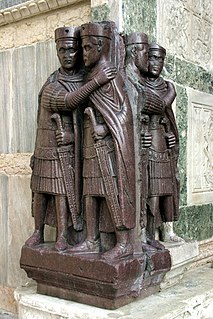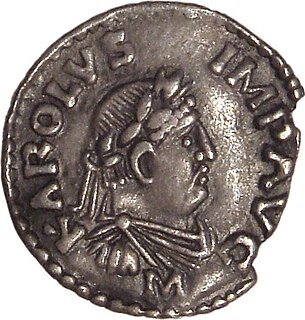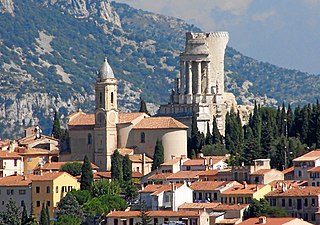Related Research Articles

Caesar Augustus was the first Roman emperor, reigning from 27 BC until his death in AD 14. His status as the founder of the Roman Principate has consolidated an enduring legacy as one of the most effective and controversial leaders in human history. The reign of Augustus initiated an era of relative peace known as the Pax Romana. The Roman world was largely free from large-scale conflict for more than two centuries, despite continuous wars of imperial expansion on the Empire's frontiers and the year-long civil war known as the "Year of the Four Emperors" over the imperial succession.

The Julio-Claudian dynasty comprised the first five Roman emperors: Augustus, Tiberius, Caligula, Claudius, and Nero. They ruled the Roman Empire from its formation under Augustus in 27 BC until AD 68, when the last of the line, Nero, committed suicide. The name "Julio-Claudian" is a historiographical term derived from the two families which composed the imperial dynasty: the Julii Caesares and Claudii Nerones.

Tiberius Caesar Augustus was the second Roman emperor, reigning from AD 14 to 37. He succeeded his stepfather, Augustus.

The Tetrarchy is the term adopted to describe the system of government of the ancient Roman Empire instituted by Roman Emperor Diocletian in 293, marking the end of the Crisis of the Third Century and the recovery of the Roman Empire. The government of the empire was divided between the two senior emperors, the augusti, and their juniors and designated successors, the caesares.

Pax Romana is a roughly 200-year-long timespan of Roman history which is identified as a period and golden age of increased as well as sustained Roman imperialism, order, prosperous stability, hegemonial power and expansion, despite a number of revolts, wars and continuing competition with Parthia. It is traditionally dated as commencing from the accession of Caesar Augustus, founder of the Roman principate, in 27 BC and concluding in 180 AD with the death of Marcus Aurelius, the last of the "Five Good Emperors". Since it was inaugurated by Augustus with the end of the Final War of the Roman Republic, it is sometimes called the Pax Augusta. During this period of approximately two centuries, the Roman Empire achieved its greatest territorial extent and its population reached a maximum of up to 70 million people. According to Cassius Dio, the dictatorial reign of Commodus, later followed by the Year of the Five Emperors and the crisis of the third century, marked the descent "from a kingdom of gold to one of iron and rust".

The Holy Roman Emperor, originally and officially the Emperor of the Romans during the middle ages, and also known as the German-Roman Emperor since the early modern period, was the ruler and head of state of the Holy Roman Empire. The Empire was considered by the Roman Catholic Church to be the only legal successor of the Roman Empire during the Middle Ages and the early modern period. The title was held in conjunction with the title of King of Italy from the 8th to the 16th century, and, almost without interruption, with the title of King of Germany throughout the 12th to 18th centuries.

The House of Hanover, whose members are known as Hanoverians is a German royal house that ruled Hanover, Great Britain, and Ireland at various times during the 17th to 20th centuries. The house originated in 1635 as a cadet branch of the House of Brunswick-Lüneburg, growing in prestige until Hanover became an Electorate in 1692. George I became the first Hanoverian monarch of Great Britain and Ireland in 1714. At Victoria's death in 1901, the throne of the United Kingdom passed to her eldest son Edward VII, a member of the House of Saxe-Coburg and Gotha. The last reigning members of the House lost the Duchy of Brunswick in 1918 when Germany became a republic.

The Ara Pacis Augustae is an altar in Rome dedicated to Pax, the Roman goddess of Peace. The monument was commissioned by the Roman Senate on July 4, 13 BC to honour the return of Augustus to Rome after three years in Hispania and Gaul and consecrated on January 30, 9 BC. Originally located on the northern outskirts of Rome, a Roman mile from the boundary of the pomerium on the west side of the Via Flaminia, the Ara Pacis stood in the northeastern corner of the Campus Martius, the former flood plain of the Tiber River and gradually became buried under 4 metres (13 ft) of silt deposits. It was reassembled in its current location, now the Museum of the Ara Pacis, in 1938, turned 90° from its original orientation so that the original western side now faces south.

The Roman emperor was the ruler of the Roman Empire during the imperial period. The emperors used a variety of different titles throughout history. Often when a given Roman is described as becoming "emperor" in English, it reflects his taking of the title Augustus or Caesar. Another title often used was imperator, originally a military honorific. Early emperors also used the title Princeps Civitatis. Emperors frequently amassed republican titles, notably princeps senatus, consul and pontifex maximus.

Publius Quinctilius Varus was a Roman general and politician under the first Roman emperor Augustus. Varus is generally remembered for having lost three Roman legions when ambushed by Germanic tribes led by Arminius in the Battle of the Teutoburg Forest, whereupon he took his own life.
Princeps is a Latin word meaning "first in time or order; the first, foremost, chief, the most eminent, distinguished, or noble; the first man, first person". As a title, "princeps" originated in the Roman Republic wherein the leading member of the Senate was designated princeps senatus. It is primarily associated with the Roman emperors as an unofficial title first adopted by Augustus in 23 BCE. Its use in this context continued until the reign of Diocletian at the end of the third century. He preferred the title of dominus, meaning "lord" or "master". As a result, the Roman Empire from Augustus to Diocletian is termed the "principate" (principatus) and from Diocletian onwards as the "dominate" (dominatus). Other historians define the reign of Augustus to Severus Alexander as the Principate, and the period afterwards as the "Autocracy".

The Roman provinces were the administrative regions of the Roman Empire outside of Italy that were controlled by the Romans under the Republic and later under the Empire. Each province was ruled by a Roman appointed as governor.

Caesar is a title of imperial character. It derives from the cognomen of Julius Caesar, the Roman dictator. The change from being a familial name to a title adopted by the Roman Emperors can be dated to about 68/69 AD, the so-called "Year of the Four Emperors".

The Principate is the name sometimes given to the first period of the Roman Empire from the beginning of the reign of Augustus in 27 BC to the end of the Crisis of the Third Century in 284 AD, after which it evolved into the so-called Dominate.

La Turbie is a commune in the Alpes-Maritimes department in southeastern France.

Augustus of Prima Porta is a full-length portrait statue of Augustus Caesar, the first emperor of the Roman Empire. The marble statue stands 2.08 meters tall and weighs 1,000 kg. The statue was discovered on April 20, 1863 at the Villa of Livia owned by Augustus’ third wife, Livia Drusilla in Prima Porta. Livia had retired to the villa after Augustus's death in AD 14. Carved by expert Greek sculptors, the statue is assumed to be a copy of a lost bronze original displayed in Rome. The Augustus of Prima Porta is now displayed in the Braccio Nuovo of the Vatican Museums.

Augustus was an ancient Roman title given as both name and title to Gaius Octavius, Rome's first Emperor. On his death, it became an official title of his successor, and was so used by Roman emperors thereafter. The feminine form Augusta was used for Roman empresses and other females of the Imperial family. The masculine and feminine forms originated in the time of the Roman Republic, in connection with things considered divine or sacred in traditional Roman religion. Their use as titles for major and minor Roman deities of the Empire associated the Imperial system and Imperial family with traditional Roman virtues and the divine will, and may be considered a feature of the Roman Imperial cult.
Dynamis, nicknamed Philoromaios, was a Roman client queen of the Bosporan Kingdom during the Late Roman Republic and part of the reign of Augustus, the first Roman Emperor. Dynamis is an ancient Greek name which means the “powerful one”. She was a monarch of Iranian and Greek Macedonian ancestry. She was the daughter of King Pharnaces II of Pontus and his Sarmatian wife. She had an older brother called Darius and a younger brother called Arsaces. Her paternal grandparents had been the monarchs of the Kingdom of Pontus, Mithridates VI of Pontus and his first wife Laodice, who was also his sister. Dynamis married three times. Her husbands were Asander, a certain Scribonius and Polemon I of Pontus. According to Rostovtzeff, she also had a fourth husband, Aspurgos.

The Meroë Head, or Head of Augustus from Meroë, is a larger-than-life-size bronze head depicting the first Roman emperor, Augustus, that was found in the ancient Nubian site of Meroë in modern Sudan in 1910. Long admired for its striking appearance and perfect proportions, it is now part of the British Museum's collection. It was looted from Roman Egypt in 24 BC by the forces of queen Amanirenas of Kush and brought back to Meroe, where it was buried beneath the staircase of a temple.
References
- ↑ Joseph Hilarius Eckhel, Doctrina Numorum Veterum, v. pp. 203, 204.
- ↑ Dictionary of Greek and Roman Biography and Mythology , William Smith, Editor.
| GENS | This article about Roman gentes is a stub. You can help Wikipedia by expanding it. |